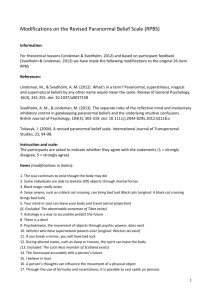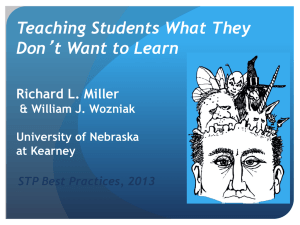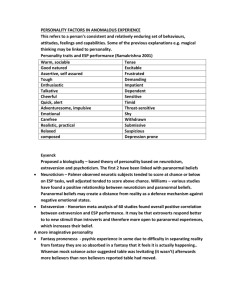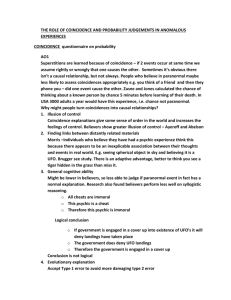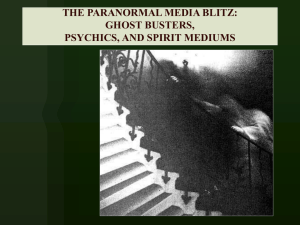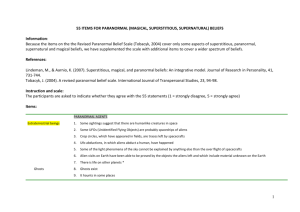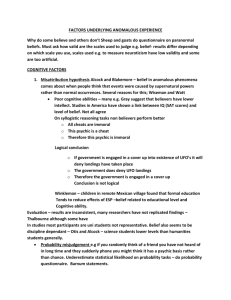TOBACYK ORIGINAL 1983
advertisement
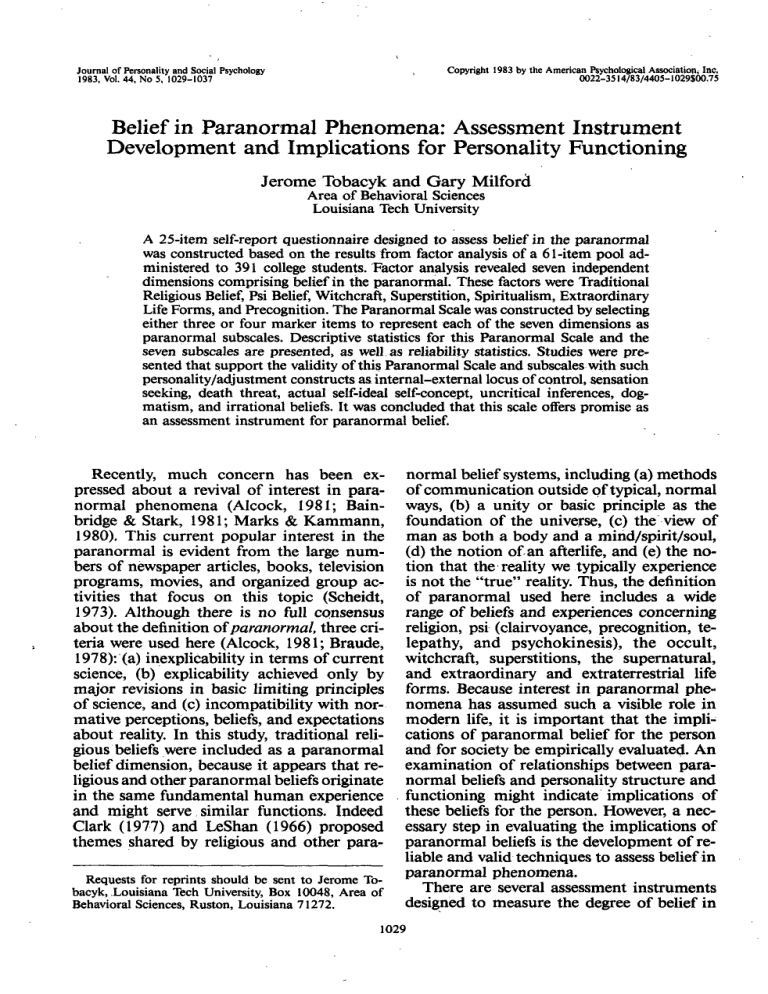
Copyright 1983 by the American Psychological Association, Inc. 0022-3514/83/4405-l029$00.75 Journal of Personality and Social Psychology 1983, Vol. 44, No 5, 1029-1037 Belief in Paranormal Phenomena: Assessment Instrument Development and Implications for Personality Functioning Jerome Tobacyk and Gary Milford Area of Behavioral Sciences Louisiana Tech University A 25-item self-report questionnaire designed to assess belief in the paranormal was constructed based on the results from factor analysis of a 61-item pool administered to 391 college students. Factor analysis revealed seven independent dimensions comprising belief in the paranormal. These factors were Traditional Religious Belief, Psi Belief, Witchcraft, Superstition, Spiritualism, Extraordinary Life Forms, and Precognition. The Paranormal Scale was constructed by selecting either three or four marker items to represent each of the seven dimensions as paranormal subscales. Descriptive statistics for this Paranormal Scale and the seven subscales are presented, as well as reliability statistics. Studies were presented that support the validity of this Paranormal Scale and subscales with such personality/adjustment constructs as internal-external locus of control, sensation seeking, death threat, actual self-ideal self-concept, uncritical inferences, dogmatism, and irrational beliefs. It was concluded that this scale offers promise as an assessment instrument for paranormal belief. Recently, much concern has been expressed about a revival of interest in paranormal phenomena (Alcock, 1981; Bainbridge & Stark, 1981; Marks & Kammann, 1980). This current popular interest in the paranormal is evident from the large numbers of newspaper articles, books, television programs, movies, and organized group activities that focus on this topic (Scheldt, 1973). Although there is no full consensus about the definition of paranormal, three criteria were used here (Alcock, 1981; Braude, 1978): (a) inexplicability in terms of current science, (b) explicability achieved only by major revisions in basic limiting principles of science, and (c) incompatibility with normative perceptions, beliefs, and expectations about reality. In this study, traditional religious beliefs were included as a paranormal belief dimension, because it appears that religious and other paranormal beliefs originate in the same fundamental human experience and might serve similar functions. Indeed Clark (1977) and LeShan (1966) proposed themes shared by religious and other paraRequests for reprints should be sent to Jerome Tobacyk, .Louisiana Tech University, Box 10048, Area of Behavioral Sciences, Ruston, Louisiana 71272. normal belief systems, including (a) methods of communication outside of typical, normal ways, (b) a unity or basic principle as the foundation of the universe, (c) the view of man as both a body and a mind/spirit/soul, (d) the notion of an afterlife, and (e) the notion that the reality we typically experience is not the "true" reality. Thus, the definition of paranormal used here includes a wide range of beliefs and experiences concerning religion, psi (clairvoyance, precognition, telepathy, and psychokinesis), the occult, witchcraft, superstitions, the supernatural, and extraordinary and extraterrestrial life forms. Because interest in paranormal phenomena has assumed such a visible role in modern life, it is important that the implications of paranormal belief for the person and for society be empirically evaluated. An examination of relationships between paranormal beliefs and personality structure and functioning might indicate implications of these beliefs for the person. However, a necessary step in evaluating the implications of paranormal beliefs is the development of reliable and valid techniques to assess belief in paranormal phenomena. There are several assessment instruments designed to measure the degree of belief in 1029 1030 JEROME TOBACYK AND GARY MILFORD paranormal phenomena (Blum & Blum, such a subscale structure may allow mean1974; Jones, Russell, & Nickel,,1977; Killen, ingful study of relationships between differWildman, & Wildman, 1974; Randall & Des- ent paranormal belief dimensions and criterosiers, 1980; Scheidt, 1973). Although these rion variables. assessment instruments contribute to our understanding of paranormal beliefs, there Method is a need for improved methodology. For example, most instruments used to assess para- Construction of the Item Pool normal belief are primarily rationally deThe experimenter selected 61 items that he judged rived. That is, the experimenter constructed would sample as wide a range of paranormal beliefs as a paranormal belief-assessment instrument possible. Some items were selected or modified from based on a priori assumptions about what existing assessment instruments. Other items were conconstitutes paranormal belief. Some experi- structed by the experimenter. menters (Randall & Desrosiers, 1980) have assumed that the structure of paranormal Subjects belief is largely unidimensional. That is, they Subjects were 391 Louisiana Tech University students have assumed that there is a general person- enrolled in various introductory psychology courses. The ality trait of "belief in the paranormal," and mean age of subjects was 20.2 years (SD = 3.3). There the construction of their assessment instru- were 201 males (mean age = 20.4, SD = 2.7) and 190 ment has been consistent with this assump- females (mean age = 20.1, SD = 3.3). tion. Other experimenters (Scheidt, 1973) have assumed that there are two or more rel- Procedure atively independent dimensions of paranorSubjects were administered the 61 paranormal belief mal belief and have constructed assessment items in classroom settings and were instructed to rate their degree of agreement with each of the items on a instruments accordingly. However, the actual structure of paranor- S-point rating scale. The points on this rating scale ranged from 1 ("strongly disagree with this item"), mal belief in the population remains an em- through 3 ("undecided or don't know"), to 5 ("strongly pirical question. A more valid procedure in agree") with that ite(m. the construction of a paranormal belief-assessment instrument might be first, to assess Method of Analysis the structure of paranormal belief in a samThe ratings of the 61 paranormal belief items were ple and, second, to base the construction of intercorrelated with Pearson product-moment correlaan assessment instrument on the paranormal tions and factor analyzed using a principle axis method. belief structure obtained in that sample. Promax oblique rotations revealed little evidence of deThis investigation reports on the construc- pendence between factors, which allowed for the use of tion of a scale designed to measure degree of orthogonal rotations. The 13-factor varimax solution, as the most clear, accounted for 60,7% of the belief in paranormal phenomena based on selected total variance. Of these 13 factors, 7 appeared meaningthis recommended strategy. This investiga- fully interpretable as common factors. Remaining faction began with an item pool designed to as- tors were primarily singlets and doublets that were unsess a wide variety of paranormal beliefs. This stable through further rotations. The items that were marker items (that is, loaded > item pool was administered to a sample of ±.50) for each of the seven factors were examined, and subjects. Then, on the basis of findings from the factors were interpreted and labeled by the experifactor analysis, the dimensions comprising menter. the structure of paranormal belief in the samFactor 1 (Traditional) Religious Belief) accounted for ple were identified. Next, a paranormal scale 17.2% of the total variance. Each of the 14 marker items an aspect of the traditional Christian religious was constructed that included items repre- concerned belief system. senting each of the major independent diFactor 2 (Psi Beliefs) accounted for 12% of the total mensions found to comprise paranormal be- variance. The four marker items for Factor 2 concerned lief structure. This factor-analytic approach either psychokineses or mental telepathy. Factor 3, (Witchcraft) accounted for 6.9% of the total to scale development allows the construction Each of the six marker items for this factor of paranormal subscales, with each subscale variance. concerned a form of witchcraft. For example, the items reflecting a different paranormal belief di- concerned black magic, voodoo, spells, and witches. Factor 4 (Superstition) accounted for 3.9% of the total mension. The use of a paranormal scale with PARANORMAL PHENOMENA 1031 variance. Each of the three marker items concerned a (229 males and 183 females). Note that the popular superstition. number of males and females does not equal Factor 5 (Spiritualism) accounted for 3.1 % of the total the total number of subjects, due to the loss variance. This factor is associated with the endorsement of several paranormal beliefs that are associated with the of information for 12 subjects. Table 3 shows spiritualistic ideology, such as communication with the the descriptive statistics (Ms and SDs) for the dead, astral projection, and reincarnation. full Paranormal Scale and for the seven paraFactor 6 (Extraordinary Life Forms) accounted for 3% normal subscales for the full, male and feof the total variance. Each of the three marker items concerned a life form whose existence is controversial, male sample. Also provided are the results such as the Loch Ness monster, Big Foot, and the abom- of a series of I tests conducted between males inable snowman. It is noted that the item "There is life and females on the full Paranormal Scale on other planets" loaded moderately (.41) on this factor. scores and on each of the seven paranormal However, the magnitude of the factor loading of this item, subscale scores. although moderate, did not reach the .SO criterion The full Paranormal Scale score for the full needed to be retained as a marker item. Factor 7 (Precognition) accounted for 2.1 % of the total sample was 76.87, which indicates that the variance. All three marker items concerned predicting average score for each of the 25 Paranormal the future via paranormal means. Scale items in this sample was approximately Note that all seven factors had clear, consistent interpretations. Also note that, in this sample, the structure 3.07. This indicates a slight tendency to of paranormal belief is clearly multidimensional. The "slightly agree with" or "express belief in" first, that is, the largest, factor obtained accounted for the 25 items overall, because 3.0 is the midonly 17.2% of the total variance. This amount_of total point of the rating scale. As indicated by an variance is clearly too small to support a general factor interpretation. Such a general factor interpretation would inspection of the subscale scores for the full be necessary if one, argued for a single "Belief in the sample, the three paranormal subscales with average scores above 3, which indicates a ten^ Paranormal" dimension or personality trait. Next, a 25-item Paranormal Scale was constructed by dency to agree with or express belief in the selecting the clearest marker items for each of the seven subscale items, were Traditional Religious factors. There were two criteria for including an item in the Paranormal Scale: (a) the item must possess one of Belief, with the highest mean score, (M = the largest magnitude factor loadings on a particular fac- 4.2), Psi Belief (M = 3.19), and Precognition tor, and (b) the item must clearly reflect the theme of the (M - 3.20). The most strongly disagreed-with factor it is selected to represent. subscales, indicating the least-expressed beThis item-selection procedure resulted in a 25-item paranormal scale. Four of the seven factors are each rep- lief, were Superstition, with the lowest mean resented by four marker items. For the three remaining score (M = 2.08) and Spiritualism (M = 2.64). factors (Superstitions, Extraordinary Life Forms, and Also, as indicated in Table 3, although the Precognition), each factor was represented by three females recorded greater full Paranormal marker items. For each of the 25 items, the theme of the Scale scores (M = 77.98), which showed factor each item represents, as well as the loading of each item on its factor, are listed in Table 1. The loading of greater agreement or belief in the 25 paraeach, of the 25 items on each of the seven factors are normal items, than did the males (M = presented in Table 2. 76.01), this difference was not statistically This 25-item Paranormal scale has several strengths significant, f(410) = -1.67, p < .10. due to its factor-analytic derivation. First, rather than However, when the paranormal subscales based on a priori assumptions of the experimenter, it is based on a direct, empirical examination of the structure are inspected, sex differences become clearer. of paranormal belief in a college student sample. Second, As indicated in Table 3, for two of the parabecause each of the seven independent dimensions of normal subscales (Traditional Religious Beparanormal belief is represented by three or four discrete items, a separate subscale score can be obtained for each - lief and Precognition) females recorded sigof the seven separate paranormal dimensions. The con- nificantly greater mean scores than did males, vergent and discriminant properties of these subscales which indicated greater belief in the phenomcan be studied in relation to criterion variables. ena assessed by these two subscales. However, Results and Discussion Descriptive Statistics for the Paranormal Scale The 25-item Paranormal Scale was administered to 424 undergraduate students on the Extraordinary Life Forms subscale, males recorded a significantly greater mean score, which indicated greater belief, than did females. This finding is of interest because it is often contended that females are greater believers in paranormal phenomena than are males. Concerning certain specific dimen- 1032 JEROME TOBACYK AND GARY MILFORD Table 1 The 25-Item Paranormal Scale Classified According to Factor-Analytically Derived Subscale With Listings of Factor Loadings Item no. Loading Subscales Factor 1: Traditional Religious Belief subscale 1 8 15 22 .77 .74 .72 .78 . The soul continues to exist though the body may die. There is a devil. I believe in God. There is a heaven and hell. Factor 2: Psi subscale 2 9 16 23 .79 .74 .69 -.51* Some individuals are able to levitate (lift) objects through mental forces. Psychokinesis, the movement of objects through psychic powers, does occur. A person's thoughts can influence the movement of a physical object. Mind reading is not possible. Factor 3: Witchcraft subscale 3 10 17 24 .75 .75 .68 .55 Black magic really exists. Witches do exist. Voodoo is a real method to use paranormal powers. There are actual cases of Voodoo death. 4 11 18 .76 .75 .69 Black cats can bring bad luck. If you break a mirror, you will have bad luck. The number " 13" is unlucky. Factor 4: Superstition subscale Factor 5: Spiritualism subscale 5 12 19 25 .73 .72 .53 .50 Your mind or soul can leave your body and travel (astral projection). During altered states, such as sleep or trances, the spirit can leave the body. Reincarnation does occur. It is possible to communicate with the dead. Factor 6: Extraordinary Life Forms subscale 6 13 20 .75 .76 .73 The abominable snowman of Tibet exists. The Loch Ness monster of Scotland exists. Big Foot exists. Factor 7: Precognition subscale 7 14 21 .64 .54 -.69* Dreams can provide information about the future. Some people have the ability to predict the future. The idea of predicting the future is foolish. Note, n = 391. * Item is reversed for scoring purposes. sions of the paranormal, it appears that males are significantly greater believers than are females. Test-retest reliability of the 25-item Paranormal Scale over a 4-week interval was 89 for a 25-subject sample. Test-retest rehabilities for each of the seven separate subscales ranged from .60 to .87 over a 4-week interval. These subscale reliability coefficients were Traditional Religious Belief (.75), Psi Belief (.84), Witchcraft (.69), Superstition (.67), Spiritualism (.66), Extraordinary Life Forms (.82), and Precognition (.60). Mercorrelatiom Among Pamnormal Subscales A listing of Pearson product-moment intercorrelations among the seven Paranormal subscales is provided in Table 4. Note that PARANORMAL PHENOMENA 1033 Table 2 A Listing of the 25 Paranormal Scales Factor Loadings on Each of the Seven Factors Subscale Item no. 1 1. Traditional Religious Belief 1 8 15 22 .77 .74 .72 .78 -.03 -.00 -.01 -.02 -.07 -.01 -.01 .08 .79 .74 .69 .20 .21 .17 .00 .06 -.03 -.51 -.01 .07 .12 .09 .01 :23 .75 .75 .68 .55 -.01 -.00 -.04 .10 .11 .11 .24 .10 .69 .76 .75 .24 -.02 -.04 .12 .09 .06 2 9 16 23 2. Psi -.02 -.04 -.07 3 10 17 24 3. Witchcraft .18 .02 .03 .06 .02 .06 .02 .03 4 11 18 -.14 ' 5. Spiritualism 5 12 19 25 -.07 -.16 -.05 -.01 .25 .19 .07 .26 .18 .10 .15 .14 .18 .35 .09 .07 6. Extraordinary Life Forms 6 13 20 -.06 .14 .09 .03 .02 .04 -.02 .08 .07 .15 .24 .27 .40 .01 .12 .03 4. Superstition -.16 .07 .15 7 7. Precognition ' 14 21 -.01 14 of 21 correlations are below .30, 6 of 21 correlations are from .31 to .40, and 1 correlation is .49. All of these correlations are in the small-to-moderate range. None is large enough to support the contention that two -.02 -.08 .03 .11 .16 .17 .10 .14 .32 .15 .10 .12 .11 .09 .05 -.04 -.02 -.25 .01 .08 .05 .09 -.00 -.06 .06 .00 .02 .13 .00 .03 .12 .04 -.00 .00 .05 -.03 .09 .22 -.03 -.03 .50 .53 .72 .73 .24 .09 .08 .08 .09 .11 .21 .06 -.00 -.00 -.07 -.17 .13 -.08 -.21 -.18 -.20 .75 ' -.00 .03 .23 .76 .73 .11 .14 .07 .21 .16 .16 .54 .64 -.12 -.05 -.69 subscales are measuring the same paranormal belief dimension. Because these correlations are based on a 424-subject sample, statistical significance alone is not an appropriate procedure to determine relatedness Table 3 Paranormal Scale and Subscale Means, Standard Deviations, and t Tests for Males and Females Full sample (» = 424) Scale and subscale Paranormal Subscales Traditional Religious Belief Psi Belief Witchcraft Superstition Spiritualism Extraordinary Life Forms Precognition Males (" = 229) Females (« = 183) t test M males versus M females M SD M SD M SD 76.87 11.97 76.01 11.93 77;98 11.70 -1.67* 4.24 3.19 2.77 2.08 2.64 2.82 3.52 .90 .84 .85 .82 .79 .83 .84 .98 .83 .92 .78 .73 .81 .85 4.48 3.22 2.80 2.13 2.66 2.61 3.65 .70 .83 .77 .85 .85 ..80 .78 -4.53** -.77 -.36 -1.28 -.39 4.74** -2.83** 4.08 3.15 2.77 2.02 2.63 2.99 3.42 Note. Twelve subjects' -sexes were unknown in the full sample due to loss of information. * p < .10. ** p < .001. *** p < .005. 1034 JEROME TOBACYK AND GARY MILFORD Table 4 Pearson Product-Moment Correlations Among the Seven Paranormal Subscales Subscale 1 . Traditional Religious Belief 2. Psi Belief 3. Witchcraft 4. Superstition 5. Spiritualism 6. Extraordinary Life Forms 7. Precognition 1 -.01 .18* .34* -,06 .10* .14* -.13* .49* .29* .32* .04 • .32* .27* .11* .33* .26* .40* .29* .07 .33* .23* Note, n = 424. * p < .05. between subscales. For example, a correlation of .09 would be statistically significant at p < .05 for a sample size of 424. The amount of shared variance (r2) between scales appears to be a more appropriate index of relatedness. The r 2 index indicates that 20 of 21 subscales share 16% or less common variance. Although subscales 2 (Psi Beliefs) and 5 (Spiritualism), with a correlation of .49, share approximately 24% common variance, evidence presented in the construct-validity section provides strong support for the discriminant validity of these subscales. Thus, it is concluded that the intercofrelations among Paranormal subscales support the notion that these seven subscales are measuring different paranormal belief dimensions. Construct Validity of the Paranormal Seale and Implications of Paranormal Beliefs for Personality Functioning Several findings support the construct validity of the Paranormal Scale and the discriminant validity of the paranormal subscales, as well as show implications of paranormal beliefs for personality functioning. The Paranormal Scale and each of seven personality-assessment instruments were administered to separate college student samples, with «s ranging from 51 to 96. The seven instruments were (a) the Locus of Control Scale, a measure of internal-external control (Rotter, 1966), (b) the Sensation Seeking Scale, a measure of individual differences in optimal level of simulation and arousal (Zuckerman, 1971), (c) the Threat Index, a measure of death threat (Hays, 1974), (d) an actual self-ideal self-concept discrepancy measure, thought to reflect level of adjustment or self-esteem (Hays, 1974), (e) the Uncritical Inferences Test, a measure of the characteristic degree of inference making beyond the facts given by observation (Haney, 1954), (f) the Dogmatism Scale (Form E), a measure of the degree of cognitive openness/closedness (Rokeach, 1960), and (g) an Irrational Belief Questionnaire (Newmark, Frerking, Cook, & Newmark, 1973), a measure of Ellis's (1962) Irrational Beliefs. These seven assessment instruments were selected because, due to theoretical considerations, they were hypothesized to be related to paranormal beliefs. Correlations between Paranormal Scale and subscale scores with scores on each of these seven instruments are listed in Table 5. Major hypotheses and findings reported in Table 5 are discussed below. Because paranormal phenomena frequently concern external forces that effect individual lives, it was hypothesized that positive correlations would be recorded between paranormal-scale and subscale scores and locus-of-control scale scores. As hypothesized, greater (more external) locus-of-control scores (associated with the belief that one's life reinforcements are determined by external forces) were significantly correlated with (a) full Paranormal Scale scores (r = .28, p < .009), and (b) Extraordinary Life Forms subscale scores (r = .22, p < .04), Each of the six remaining subscales recorded positive, though nonsignificant, correlations with locus-ofcontrol scale scores. It was hypothesized that greater sensation seeking would be associated with greater reported belief in paranormal phenomena, be- 1035 PARANORMAL PHENOMENA Table 5 Correlations for Paranormal Scale and Subscale Scores With Internal-External Scale, Sensation Seeking Scale, Threat Index, Actual Self-Ideal Self-Concept, Uncritical Inference Test, Dogmatism Scale, and Irrational Belief Scale Scores I-E scale (« = 87) Scale and subscale Paranormal Subscales Traditional Religious Belief , Psi Beliefs Witchcraft Superstitious Spiritualism Extraordinary Life Forms Precognition r P .28 .009 Sensation seeking (n = 51) r .11 P Threat index (n = 78) r -.11 P Actual self ideal self selfconcept (« = 78) r -.08 p < Uncritical inference (n = 96) r P .03 .17 .09 .14 .19 .07 .09 .12 -.14 .34 .001 -.23 .05 -.22 .05 -.07 .03 .23 .10 -.01 -.01 .04 -.01 .01 -.07 .07 .01 -.01 -.23 .03 .24 .08 ,13 .00 .22 .04 .15 .13 -.01 -.13 -.09 cause belief in many of these phenomena may reflect a more exciting and mysterious world view than that based on more normative beliefs. However, no significant correlations between Paranormal Scale or subscale scores and Sensation-Seeking Scale scores were obtained. Two Paranormal subscales showed trends in the hypothesized direction: Psi Beliefs (r=.23, p < .10) and Spiritualism (r = .24, p < .08). It is noted that these correlations were based on the smallest n in the study (n - 51) and that correlations of these magnitudes would be significant for larger samples. Some researchers (Becker, 1973; Rank, 1968) contend that a basic function of paranormal (including religious) beliefs is to exorcise fear of death by positing personal spiritual survival of physical death. Therefore, it was hypothesized that scores that indicate greater belief in paranormal phenomena, which reflect the notion of survivability of physical death (Traditional Religious Belief and Spiritualism subscales), would be associated with smaller scores on the Threat Index (which indicates lesser death threat). As hypothesized, Traditional Religious Belief subscale scores were significantly and negative correlated with Threat Index scores (r = -.23, p < .05). -.21 .06 -.00 .12 -.15 Dogmatism scale (n = 86) r P .14 .18 .04 .22 .10 .01 -.08 .12 .09 .04 Irrational belief scale (n = 86) r P .18 .09 -.01 .17 .16 .27 .21 .01 .04 -.02 .02 Although earlier studies (Adorno, FrenkelBrunswick, Levinson, & Sanford, 1950; Emme, 1940; Mailer & Lundeen, 1933) reported significant relationships between paranormal belief and such constructs as anxiety, maladjustment and emotionality, more recent studies (Jones et al., 1977) did not report such relationships. Therefore, it was expected that, generally, paranormal belief would not be associated with greater actual self-ideal self-discrepancy. It was hypothesized that Traditional Religious Belief subscale scores would be associated with lesser actual self-ideal self-discrepancy because of the extensive support systems provided by traditional religious institutions in our culture. As hypothesized, Traditional Religious Belief subscale scores were significantly and negatively correlated with actual self-ideal self-discrepancy scores (r = —.22, p < ,05). Further, as expected, none of the other Paranormal subscale scores recorded significant correlations with actual self-ideal self-discrepancy scores. Thus, inasmuch as actual self-ideal self-discrepancy reflects adjustment or self-esteem, these two constructs are not generally associated with paranormal beliefs. Because many paranormal beliefs are inferential (not empirically verifiable), it was 1036 JEROME TOBACYK AND GARY MILFORD hypothesized that greater Paranormal Scale and subscale scores would be associated with lesser scores on the Uncritical Inferences Test (which would indicate less critical inference making). As hypothesized, Spiritualism subscale scores were significantly and negatively correlated with Uncritical Inference Test scores (r = -.23, p < .03). However, Traditional Religious Belief subscale scores were significantly and positive correlated with Uncritical Inference Test scores (r = .34, p < .001). Thus, less-critical inference making appears to be associated with only certain paranormal beliefs, such as astral projection, reincarnation, and communication with the dead. Traditional religious beliefs, which are the least culturally deviant among the paranormal beliefs, appear to be associated with less-uncritical inference making. It was not expected that dogmatism would be associated with paranormal beliefs in general. It was hypothesized that dogmatism would be associated with greater scores on paranormal subscales that are less accepted or supported in our culture, such as witchcraft, superstition, and spiritualism beliefs. As expected, Dogmatism Scale scores were not significantly correlated with full Paranormal Scale scores (r = . 14, ns). As hypothesized, Dogmatism Scale scores were significantly correlated with Witchcraft subscale scores (r = .22, p < .03). Thus, it is clear that Dogmatism is not a necessary or co-occurring condition for most paranormal beliefs. Using Berg's (1955) Deviation Hypothesis as a rationale, it was speculated that greater scores on a questionnaire based on Ellis's Irrational Beliefs (which are thought to be a cause of psychopathology; Ellis, 1962) might be associated with less-frequently held (or more culturally deviant) paranormal beliefs. Indeed, Ellis's Irrational Beliefs appear to have some negative implications for cognitive functioning. They appear to be dogmatically held and to interfere with logical inference making (Tobacyk & Milford, 1982), as may some types of paranormal beliefs. Thus, it was hypothesized that higher scores on the Irrational Belief Questionnaire would be associated with higher scores on the Witchcraft, Superstition, and Spiritualism subscales. As hypothesized, significant positive correlations were obtained between the Irrational Belief Questionnaire and the Superstition (r = .27, p < .01) and Spiritualism (r = .21, p < .04) subscales. In conclusion, it appears that this Paranormal Scale and these subscales have potential as an assessment instrument for paranormal beliefs. Paranormal beliefs appear to have implications for personality functioning, especially that which concerns locus of control, death threat, self-concept, inference making, dogmatism, and irrational beliefs. Perhaps the most significant finding in this research is that, rather than there being a single personality dimension of "belief in the paranormal," there are several relatively independent paranormal belief dimensions, some of which have different implications for personality and adjustment. References Adorno, T., Frenkel-Brunswick, E., Levinson, D., & Sanford, N. The authoritarian personality. New York: Harper, 1950. Alcock, J. Parapsychology: Science or magic? New York: Pergamon Press, 1981. Bainbridge, W., & Stark, R. Superstitions: Old and new. In K. Frazier (Ed.), Paranormal borderlands of science. Buffalo, N.Y.: Prometheus Books, 1981. Becker, E. The denial of death. New York: Free Press, 1973. Berg, I. Response bias and personality: The deviation hypothesis. Journal of Psychology, 1955, 40, 61-71. Blum, S., & Blum, L. H. Do's and Dont's: An informal study of some prevailing superstitions. Psychological Reports, 1974, 35, 567-571. Braude, S. On the meaning of "Paranormal." In J. Ludwig (Ed.), Philosophy and parapsychology. Buffalo, N.Y.: Prometheus Books, 1978. Clark, W. Parapsychology and religion. In B. Wolman (Ed.), Handbook of parapsychology. New York: Van Nostrand Reinhold, 1977. Ellis, A. Reason and emotion in psychotherapy. New York: Lyle Stuart, 1962. Emrae, E. Modification and origin of certain beliefs in superstition among 96 college students. Journal of Psychology, 1940, 10, 279-291. Haney, W. Measurement of the ability to discriminate between inferential and descriptive statements. (Doctoral dissertation, Northwestern : University, 1953). Dissertation Abstracts International, 1954, 14, 405406. (University Microfilms No. 7037) Hays, C. A methodological investigation of the threat index and the introduction of a short form. Unpublished senior thesis. University of Florida, 1974. Jones, W., Russell, D., & Nickel, T. Belief in the paranormal scale: An objective instrument to measure belief in magical phenomena and causes. JSAS Catalog of Selected Documents in Psychology, 1977, 7, 100. (Ms. No. 1577) PARANORMAL PHENOMENA Killen, P., Wildman, R., & Wildman, R. Superstitiousness and intelligence. Psychological Reports, 1974,34, 1158. LeShan, L. The medium, the mystic, and the physicist. New York: Viking Press, 1966. Mailer, J., & Lundeen, G. Superstition and emotional maladjustment. Journal of Educational Research, 1933, 27, 592-617. Marks, D., & Kammann, R. The psychology of the psychic. Buffalo, N.Y.: Prometheus Books, 1980. Newmark, C., Frerking, P., Cook, L., & Newmark, L. Endorsement of Ellis's irrational beliefs as a function of psychopathology. Journal of Clinical Psychology, 1973, 29, 300-302. Randall, X, & Desrosiers, M. Measurement of supernatural belief: Sex differences and locus of control. Journal of Personality Assessment, I960,44, 493-498. Rank, O. Art and artist: Creative urge and personality development. New York: Agathon Press, 1968. 1037 Rokeach, M. The open and the closed mind. New York: Basic Books, 1960. Rotter, J. Generalized expectancies for internal versus external control of reinforcement. Psychological Monographs. 1966, 80(1, Whole No. 609). Scheidt, R. Belief in supernatural phenomena and locus of control. Psychological Reports, 1973, 32, 11591162. Tobacyk, J., & Milford, G. Criterion validity for Ellis' irrational beliefs: Dogmatism and uncritical inferences. Journal of Clinical Psychology, 1982, 38, 605607. Zuckerman, M. Dimensions of sensation seeking. Journal of Consulting and Clinical Psychology, 1971, 36, 45-52. Received January 25, 1982 Instructions to Authors APA policy prohibits an author from submitting the same manuscript for concurrent consideration by two or more journals. Authors should prepare manuscripts according to the Publication Manual of the American Psychological Association (3rd edition). All manuscripts are subject to editing for sexist language. Manuscripts must include an abstract of 100-150 words. Instructions on tables, figures, references, metrics, and typing (all copy must be doublespaced) appear in the Manual. Articles not prepared according to the Manual will not be reviewed. For further information on content, authors should refer to the editorial in the March 1979 issue of this journal (Vol. 37, No. 3, pp. 468-469). The reference citation for any article in any JPSP section follows APA's standard reference style for journal articles; that is, authors, year of publication, article title, journal title, volume number, and page numbers. The citation does not include the section title. Manuscripts should be submitted in quadruplicate (the original and three photocopies) to the appropriate section editor. All copies should be clear, readable, and on paper of good quality. Editors' addresses appear on the inside front cover of the journal. Authors should keep a copy of the manuscript to guard against loss. Blind review is optional and must be specifically requested when a manuscript is first submitted. In those cases, authors' names and affiliations must appear only on a separate title page, included with each copy of the manuscript. Footnotes containing the identity of authors or their affiliations must be on a separate sheet. Section editors reserve the right to redirect papers among themselves as appropriate unless an author specifically requests otherwise. Rejection by one section editor is considered rejection by all, therefore a manuscript rejected by one section editor should not be submitted to another.
